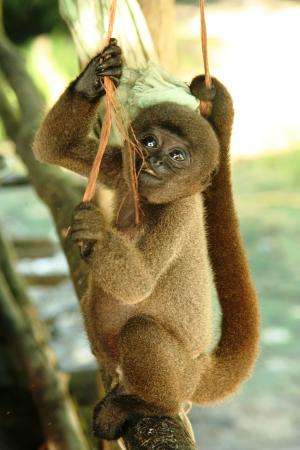Urban taste for bushmeat poses threat to Amazonian wildlife

Research has uncovered alarming evidence of an under-reported wild-meat crisis in the heart of Amazonia.
Scientists from Lancaster University and Brazil interviewed households in two Brazilian 'prefrontier' cities – cities which are surrounded by more than 90 per cent of their original forest cover.
They found virtually all urban households in these cities (Borba and Novo Aripuanã) consumed wildlife for food, including fish (99%), bushmeat (mammals and birds; 79%), turtles and tortoises (48%) and caimans (28%).
Some of the wildlife species being eaten are classed as endangered, vulnerable and threatened.
The study, published online in the journal Conservation Letters 'Wildlife harvest and consumption in Amazonia's urbanized wilderness', indicates that the previous assumption that there is low urban demand for wildlife as food, is incorrect.
Dr Luke Parry said: "The rapid urbanization of forested wilderness in the Amazon could threaten biodiversity if expanding cities drive demand for wildlife as food. There are around 73 cities such as those we studied, occupying around 1.86 million square km2 of forest. Previously it was thought that city dwellers did not consume much wildlife but we found that was not the case. In fact, nearly every household did.
"People were hunting, fishing and consuming wildlife for a number of different reasons, for some bushmeat was the most affordable protein source they could access, for others it was a question of preference for eating particular 'prestige' species."
The study found:
- Bushmeat was eaten at least once a month by nearly half (44%) of urban households
- The vast majority (79%) had consumed bushmeat during the previous 12 months
- Almost all (99%) households had consumed fish, plus chelonians (48%) and caiman (28%) during this period
- Urban households reported consuming a wide range of mammals (15 species identified in total), birds (12), fishes (62), and reptiles (7; Figure 2)
- Many of these species are vulnerable to overharvesting, reflected by IUCN threat statuses (for mammals, birds, and reptiles) including 3 endangered species, 8 vulnerable and 5 near threatened
Dr Parry said: "We need to find ways of alleviating poverty and supplying poor city-dwellers with affordable alternatives to eating wildlife so that in the long term wildlife ceases to be an economical source of protein for the poor.
"Innovative environmental governance could limit wildlife consumption to only harvest-tolerant species."
More information: Luke Parry, Jos Barlow and Heloisa Pereira, "Wildlife harvest and consumption in Amazonia's urbanized wilderness," Conservation Letters, DOI: 10.1111/conl.12151
Journal information: Conservation Letters
Provided by Lancaster University


















